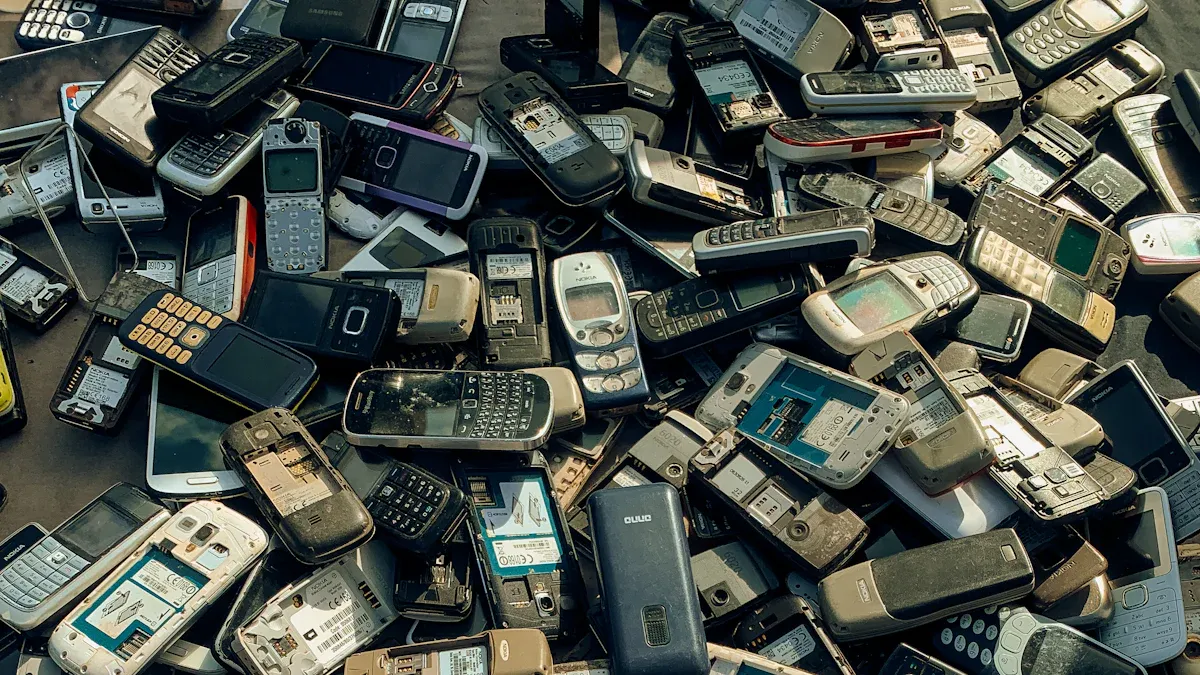
When you need to check how pure gold is, an XRF 金 测试 仪 is the best tool. This smart device gives exact results without harming the gold. It keeps valuable items, like old jewelry or gold coins, safe. You can use it to test gold, 银, and other metals without changing their shape or worth. In jobs like jewelry making or coin trading, it is very useful.
XRF tools also follow rules for finding gold. This high accuracy gives reliable results for professional work.
关键要点
An XRF 黄金测试er shows how pure gold is without harm.
Clean the gold’s surface first to get correct results.
Adjust the XRF tester daily for accurate readings on all gold types.
Check several spots on the gold to know its full quality.
Pick the right testing mode for the gold type to avoid mistakes.
Keep the testing area steady and dry for better accuracy.
Update the XRF tester’s software often to keep it working well.
Ask an expert for help with tricky samples or odd results.
Understanding XRF Gold Testers
What Is an XRF Gold Tester
An XRF金测试仪 is a special tool for checking gold purity. It shows what metals are in gold without causing any damage. Unlike acid tests, which can harm items, XRF testers are safe to use. This makes them great for testing valuable things like coins, 珠宝, or gold bars.
These tools are used in many places, like jewelry shops and metal refineries. They are also helpful for banks, 典当行, 和黄金交易商. XRF testers are very accurate, often over 99.9%, making them trusted for important deals.
How XRF or X-Ray Fluorescence Technology Works
XRF 技术 uses X-rays to study what materials are made of. When you put gold in the tester, it sends out X-rays. These X-rays hit the gold’s atoms, making them release new X-rays. The tester reads these new X-rays to find out what elements are in the gold.
Each element gives off unique energy levels. The tester measures these levels to figure out the gold’s makeup. This method is quick, safe, and very exact. Research shows XRF testers are accurate within 0.1% 自 0.2% for flat gold and better than 0.5% for small or odd-shaped pieces.
Key Features of the GoldPro XRF Gold Analyzer VR-X5
The GoldPro XRF Gold Analyzer VR-X5 is a top-notch tool for professionals. It uses advanced X-ray technology to give precise results. Here are its main features:
High Precision: It detects gold from 1% 自 99.99% with 0.05% 准确性.
User-Friendly Design: It has a touchscreen and built-in computer for easy use.
Wide Application: It tests up to 24 元素, like gold, 银, 和铂金.
Safety Features: It has high voltage protection and radiation safety.
Compact and Portable: It is small and light, so you can move it easily.
This device is great for jewelry stores, recycling centers, and other businesses. It can check gold plating and test alloys, making it a useful tool for experts.
Step-by-Step Gold Testing Techniques
Getting the Gold Ready
Cleaning the Gold Surface
Before testing, make sure the gold is clean. Dirt or oil can mess up the results. Use a soft cloth and rubbing alcohol to wipe it well. This removes anything that might confuse the XRF gold tester.
For jewelry with designs, clean the flat parts carefully. If dirt is stuck, gently scrape it off with a soft tool. Cleaning properly helps the tester check the gold without problems.
提示: Always use clean hands or gloves to handle gold. This stops dirt or oil from getting back on it.
Keeping the Gold Still and Flat
The gold must stay still and flat for good results. Put it on a stable, flat surface so it doesn’t move. Curved items, like rings, might give wrong results if not placed right.
If the gold is small or oddly shaped, use a holder to keep it steady. For gold bars or chains, test in different spots to be sure. A flat and steady sample helps the XRF tester work better.
笔记: Testing on uneven or shaky surfaces can cause mistakes. Take time to set it up right.
Setting Up the XRF Gold Tester
Using Calibration Tools
Calibration makes sure the tester gives correct results. XRF testers use special tools with known gold levels to check accuracy.
For the GoldPro XRF Gold Analyzer VR-X5, follow the guide to pick the right tool. Common ones include ISO 2678 and ISO 7137, which meet industry rules.
Calibration Tool | What It Does |
|---|---|
ISO 4064-2 | Tests water meter methods |
ISO 2678 | Calibrates 光谱仪s |
ISO 7137 | Checks measurement accuracy |
ISO/DIS 12346 | Calibrates many instruments |
ISO 8995 CIE S 008 | Measures lighting standards |
Checking Calibration Accuracy
After setting up, test a sample with known gold levels. This checks if the tester works right.
If the results are off, recalibrate and test again. Regular checks keep the tester accurate, especially for different gold types.
提示: Always check calibration at the start of your testing day. This keeps results steady all day.
Running the Test
Placing the Gold in the Tester
Put the gold inside the XRF tester’s chamber. Make sure it lies flat and stays still. The VR-X5 has a big chamber for items like coins, bars, or jewelry.
Align the gold with the tester’s window so the X-rays hit the right spot. Check the position before starting to avoid mistakes.
Understanding Purity and Composition Readings
这 XRF金测试仪 shows how pure the gold is. It gives results as percentages, showing the amount of gold in the sample. 例如, 99.99% means almost pure gold. Lower numbers mean other metals are mixed in.
Look closely at the purity numbers. They tell you the gold’s value and if it’s real. Accurate results are important for selling or investing in gold.
The GoldPro XRF Gold Analyzer VR-X5 makes this easy. Its advanced system gives exact readings, even for tricky alloys. You can trust it for testing jewelry, 硬币, or bars.
提示: Compare purity readings with industry rules to check quality. This helps avoid fake gold and ensures you have real materials.
Identifying Other Metal Components
Gold often has small amounts of other metals mixed in. 这 XRF金测试仪 finds these metals and shows their percentages. You might see silver, 铜, or platinum listed.
Knowing these metals is useful for many tasks. If you make jewelry, it helps pick the right materials. For recycling, it shows how to separate the metals.
The VR-X5 can find up to 24 元素. Its sensitive detector spots even tiny amounts of metals. This is helpful for testing gold with detailed designs or mixed metals.
笔记: If strange metals appear, check where the gold came from. Contamination or plating can change the results, so confirm the gold’s source.
By studying the results, you learn about the gold’s purity and mix. This helps you make smart choices when buying, selling, or crafting with gold.
Factors That Influence Accuracy in XRF Gold Testing
Importance of Surface Preparation
Cleaning the gold’s surface is very important for accurate testing. Dirt, oil, or residue can block the X-rays and confuse the results. This makes the readings less reliable.
To clean the gold, use a soft cloth and rubbing alcohol. For gold with designs, focus on flat areas where the tester scans. If the surface stays dirty or uneven, the tester might give wrong results about the gold’s makeup.
提示: Wear clean gloves when handling gold to avoid smudges or oils.
A clean surface helps the XRF tester work directly with the gold. This reduces mistakes and improves accuracy.
Sample Thickness and Homogeneity
The thickness and evenness of the gold sample affect testing results. Thin samples absorb X-rays differently, which can cause errors. Uneven samples may also confuse the tester and lead to wrong readings.
Make sure the gold sample is thick and even. Samples made through fusion processes are better because they are uniform. Fusion removes size differences and makes the sample consistent.
Evidence Description | Key Points |
|---|---|
Impact of Sample Thickness | Thin samples can absorb X-rays poorly, causing errors. |
Influence of Sample Preparation | Fusion creates even samples, improving sensitivity and accuracy. |
Effects of Homogeneity | Fusion makes samples uniform, reducing mistakes in testing. |
Keeping the sample thick and even helps the tester give correct results.
Environmental Conditions and Their Impact
The testing area’s environment can change how well the XRF tester works. 温度, humidity, and lighting can affect the device’s performance. 例如, moisture from high humidity can change the gold’s surface and confuse the readings.
Test gold in a dry, stable environment. Keep the area cool and avoid bright sunlight or harsh lights. These can interfere with the tester’s sensors.
笔记: The GoldPro XRF Gold Analyzer VR-X5 works well in many conditions, but a controlled environment gives better results.
By managing the testing area, you help the XRF tester give accurate gold analysis.
Avoiding User Errors During Testing
Using an XRF金测试仪 needs care to get 准确的结果. Small mistakes can cause errors, so follow the right steps.
1. Skipping the Cleaning Step
Testing dirty gold is a common mistake. Dirt or oil can block X-rays and give wrong results. Always clean the gold before testing. Use rubbing alcohol and a soft cloth to wipe it. For detailed designs, focus on flat parts where the tester scans.
提示: Wear clean gloves to stop oils from your hands getting on the gold.
2. Improper Sample Placement
Placing the gold wrong can mess up the test. If it’s not flat or steady, X-rays won’t hit evenly. This can change the readings. Always put the gold on a flat, stable surface. Use a holder for curved or odd-shaped items to keep them still.
笔记: Check the gold’s position with the tester’s window before starting.
3. Choosing the Wrong Testing Mode
Picking the wrong mode can give false results. 例如, using “High-Purity Mode” on mixed gold won’t work well. Choose the mode that matches the gold type. The GoldPro XRF Gold Analyzer VR-X5 has many modes to help you pick the right one.
4. Ignoring Calibration Requirements
Skipping calibration is a big mistake. Calibration checks if the tester works correctly. Use the right calibration tools and test accuracy before starting.
提示: Calibrate daily, especially when testing different gold types.
5. Rushing Through the Process
Hurrying can lead to errors. Take time to clean, place, and set up the gold properly. Review the results carefully to avoid missing details. Rushing often causes mistakes.
6. Overlooking Environmental Factors
Conditions like heat or humidity can affect the tester. Testing in a humid place may give bad results. Always test in a dry, stable area to avoid problems.
By avoiding these mistakes, you can trust your XRF金测试仪 results. Careful preparation and attention to detail make testing more reliable.
Best Practices for Using an XRF Gold Tester
Regular Calibration and Maintenance
Calibrating your XRF金测试仪 keeps results accurate. Calibration matches the device to industry rules, helping it measure gold correctly. Use certified tools, like ISO standards, to check accuracy. Do this daily or before testing new gold types.
Taking care of the tester is also important. Clean it often to stop dust from affecting sensors. Update the software to keep it working well. Write down maintenance and calibration details to track how it performs. These records help spot issues and keep the tester reliable.
提示: Plan regular maintenance to avoid problems during testing.
Testing Multiple Points on the Sample
Gold items can have uneven surfaces or mixed metals. Testing different spots gives a full view of the gold’s quality. 例如, a gold ring might have different metals in its band and design. Checking multiple areas helps find differences and confirm the gold’s purity.
Lay the gold flat and steady in the tester. Use holders for curved or odd-shaped items to keep them still. Test at least three spots on big pieces, like gold bars or chains. This reduces mistakes and gives better results.
笔记: Testing several points works well with devices like the VR-X5, which checks up to 20 elements in one sample.
Avoiding Contamination During Testing
Dirt or oil on gold can change test results. Always clean the gold before testing. Use a soft cloth and rubbing alcohol to remove dirt. Wear gloves to stop oils from your hands getting on the gold.
Keep the testing area clean and dust-free. Don’t place gold on dirty or uneven surfaces. If you think the gold is dirty, clean it again and retest. This helps the tester work directly with the gold for accurate readings.
提示: Store gold in clean containers to keep it safe from dirt before testing.
Keeping the Device Software Updated
Updating your XRF gold tester’s software is very important. It helps keep the device accurate and working well. Updates often fix problems, add new features, and improve how the device works. By updating, your GoldPro XRF Gold Analyzer VR-X5 stays in top shape.
Why Software Updates Matter
Software updates make the device better at testing gold and metals. Companies release updates to improve how it works, add new materials, and make it easier to use. Without updates, your device might not work as well or give outdated results.
提示: Updates also help your device follow industry rules, keeping results correct and trusted.
How to Check for Updates
Checking for updates on the GoldPro XRF Gold Analyzer VR-X5 is simple. The touchscreen and built-in computer make it easy. Follow these steps:
Open the settings menu on the touchscreen.
Find the “Software Update” or “System Update” option.
Connect to the internet using a safe network.
Follow the instructions to download and install updates.
笔记: Use a strong internet connection to avoid problems during updates.
Benefits of Updating Regularly
Updating often has many advantages:
Better Accuracy: Updates improve how well the device detects gold.
New Features: Updates may add new tools or testing modes.
Improved Security: Updates protect the device from risks or bugs.
Longer Use: Regular updates keep the device running smoothly.
Best Practices for Software Updates
To get the most from updates, follow these tips:
Set Reminders: Check for updates every month or before busy times.
Save Data: Backup test results before updating to avoid losing them.
Check Compatibility: Make sure the update works with your device model.
Ask for Help: Contact customer support if you face any issues.
提示: Write down update dates and versions. This helps you track changes and stay updated.
By keeping your GoldPro XRF Gold Analyzer VR-X5 updated, you ensure it works its best. Updates improve performance and help you stay ahead in gold testing.
Common Mistakes to Avoid When Using an XRF Gold Tester
Skipping Calibration Steps
Calibration helps the tester give correct results. Without it, the device might show wrong gold purity levels. This step aligns the tester with industry rules for accuracy. Skipping calibration can lead to big mistakes.
例如, a tester might say gold is 98% pure when it’s really 99.9%. This error can cause confusion and money loss. One user found their tester gave bad readings because they skipped calibration.
To prevent this, always calibrate before testing. Use certified tools and follow the instructions. The GoldPro XRF Gold Analyzer VR-X5 needs daily calibration, especially for different gold types or scrap. Regular calibration keeps results reliable.
提示: Test a sample with known purity after calibrating to check accuracy.
Testing Dirty or Contaminated Samples
Dirt or oil on gold can confuse the tester. These block the X-rays, giving wrong results. Dirty gold often shows lower purity than it really has.
Clean the gold before testing. Use rubbing alcohol and a soft cloth to remove dirt. For designs, clean flat areas carefully. If the gold is very dirty, clean it more than once.
Dust in the tester’s chamber can also affect results. Keep the chamber clean and wear gloves to avoid touching the gold with oily hands.
笔记: Scrap gold needs extra cleaning since it often has mixed metals. Cleaning well helps the tester work better.
Misinterpreting Results Without Cross-Verification
Reading XRF results needs care. The tester gives exact data, but mistakes can happen if you misread numbers. 例如, low purity might mean contamination or skipped calibration, not fake gold.
Always double-check results to avoid errors. If numbers look strange, clean the gold and recalibrate the tester. Test different spots on the gold to find differences. Scrap gold may have mixed metals that change purity readings.
The GoldPro XRF Gold Analyzer VR-X5 makes this easier with clear data and a simple interface. 仍然, it’s important to verify results. Checking twice helps you make smart choices when testing gold for buying, selling, or recycling.
提示: Write down your results to compare later. This helps spot problems with the tester or samples.
Ignoring Manufacturer Guidelines
Not following the maker’s rules can cause wrong results. It might even harm your XRF金测试仪. These rules help you get accurate readings and keep the device working well. By following them, your GoldPro XRF Gold Analyzer VR-X5 will work its best.
Why Manufacturer Guidelines Matter
Makers give clear steps to use their devices correctly. These steps include cleaning, 校准, and testing. Skipping these can cause mistakes, waste time, and give bad results. 例如, if you don’t clean the gold or calibrate the tester, the readings might be wrong.
提示: Always read the manual before using your XRF gold tester. It has important details for your model.
Key Guidelines You Should Follow
Here are some important rules from the maker to follow:
Sample Surface and Preparation: Clean and smooth surfaces help X-rays work better. Dirt or rough spots can mess up the results.
校准: Calibrate often with certified tools to get correct readings. This is very important for different gold types or alloys.
检测限: 高级探测器, like the Si-PIN in the VR-X5, need proper setup to find tiny elements.
Testing Depth: Some testers check both surface and inside layers. Follow the manual to pick the right mode for your sample.
Common Mistakes When Ignoring Guidelines
Not following the maker’s rules can cause problems like:
Inconsistent Results: Skipping calibration or using the wrong mode can give different results for the same gold.
Device Malfunctions: Using the tester in bad conditions can damage its parts.
Reduced Accuracy: Not cleaning or using wrong settings can make readings less precise.
笔记: The GoldPro XRF Gold Analyzer VR-X5 has a touchscreen that helps guide you. Use it to avoid mistakes.
How to Stay on Track
To follow the maker’s rules, try these tips:
Keep the manual nearby for quick help.
Train everyone on how to use and care for the tester.
Do regular calibration and maintenance checks.
Update the software when the maker suggests.
By following these rules, you protect your tester and get accurate results. The XRF Gold Analyzer VR-X5 is a great tool, but it works best when used properly. Stick to the maker’s instructions to keep it working well for a long time.
When to Ask for Expert Help with Gold Testing
Testing Complicated Gold Alloys or Rare Samples
Some gold items have tricky mixes or rare materials. These can be hard to test with regular XRF gold testers. Items like antique coins or jewelry with unique designs may confuse the device. If your tester can’t find all metals or gives unclear results, ask an expert.
Experts use special methods to check these tough samples. They can find rare metals and confirm how pure the gold is. 例如, old coins or detailed jewelry often need expert testing for accurate results.
提示: If a sample looks strange or has unknown origins, get expert help to avoid mistakes.
Fixing Unsteady or Wrong Results
Sometimes, your tester might give different results each time. This can happen if the device isn’t calibrated right, the environment affects it, or there’s a user mistake. If your tester shows odd readings or doesn’t match expected purity, call a professional.
Experts can double-check your results using other methods like fire assay or ICP analysis. These tests are very precise and can confirm your XRF tester’s accuracy.
笔记: Calibrating often and cleaning samples well can prevent errors. But if problems continue, experts can ensure correct results.
Solving Device Problems or Errors
Your XRF gold tester might stop working sometimes. Issues like software bugs, broken sensors, or calibration troubles can happen. If your device shows errors or stops working, contact the maker or a trained technician.
Professionals can fix your tester and make it work again. They can also teach you how to care for it to avoid future issues. 例如, if your XRF Gold Analyzer VR-X5 gives strange readings, a technician can recalibrate or repair it.
提示: Keep the manual nearby and try fixing small issues first. If the problem doesn’t go away, let an expert handle it.
Using an XRF gold tester needs four main steps: prepare, calibrate, test, and read results. Clean the gold and keep it steady for better accuracy. Calibrate often, like using the Fundamental Parameter method, to get exact results. Test different spots on the gold and check the data carefully to know its purity and mix.
Follow good habits, like taking care of your tester and updating its software, to keep it working well. Learning the right way to use it makes you better and helps your tester last longer. By doing these steps, you’ll get clear and correct results every time.
常问问题
How accurate is the GoldPro XRF Gold Analyzer VR-X5?
这 VR-X5 gives gold purity results with 0.05% 准确性. It can find up to 24 元素, making it great for alloys and pure metals. Its advanced Si-pin探测器 ensures reliable readings for professional use.
How often should I calibrate the XRF gold tester?
Calibrate daily or before testing new gold types. Regular calibration keeps results accurate.
提示: Always calibrate after moving the tester or testing unusual samples.
Does the VR-X5 work for small or odd-shaped gold samples?
是的, the VR-X5 works well with small or oddly shaped items. Its large chamber and sensitive detector give accurate readings. Use holders to keep uneven items steady for better results.
What metals can the VR-X5 detect besides gold?
The VR-X5 finds up to 24 元素, like silver, 铂, 铜, and palladium. It gives detailed results for alloys and mixed metals.
Is the VR-X5 safe to use?
是的, the VR-X5 is safe. It has high-voltage protection and radiation safety features. These keep users and samples secure during testing.
笔记: Follow the maker’s safety rules for the best experience.
What should I do if the tester gives inconsistent results?
Clean the sample and recalibrate the tester. Test different spots on the item to confirm the readings. If problems continue, ask a professional for help or repairs.
警报: Avoid testing in wet or unstable places to stop errors.







WhatsAPP
扫描WhatsApp二维码和我们联系吧。